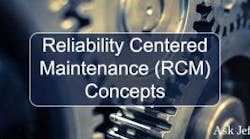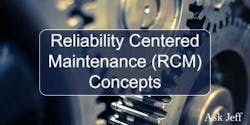Just because we can doesn't mean we should: Answering the “Is it worth doing?” question
Sean, facility maintenance manager, Arizona
Answer: In RCM2 or RCM3 analysis, when determining the proactive maintenance strategy for a failure mode, i.e. a condition-based task, a time-based scheduled restoration task, or a scheduled discard task, you must answer two questions with “yes” for the task to be valid.
- Is the task proposed technically feasible?
- Is the task worth doing?
Consider the failure mode “bearing seized” on a centrifugal pump. While it may be technically feasible to use vibration analysis to find the bearing in the act of failure, it may not be worth doing from a cost perspective, depending on the operating content and the failure consequence. Let’s work through two simple and brief scenarios to explain the concept. For both, the cost of production downtime is $10,000 per hour.
In Scenario Alpha, a single centrifugal standalone Pump A transfers product from Tank 1 to Tank 2. When the level in the tank drops to the low-level refill point, the PLC logic would call for Pump A to run until the high-level point is reached. With the bearing seized, the PLC logic should detect the failure either via level, flow, or motor tripping as examples and alarm the operator. At that point, we have 2.5 hours of level remaining in Tank 2. We estimate the pump will take four hours to repair. As production losses occur along with the cost of the repair, the consequences are operational. The downtime cost would be $15,000 due to not having the product for 1.5 hours (4 hours minus 2.5 hours). The cost of running vibration analysis on Pump A every month is $200. We have a total of six of these pumps in use across the site, and we know from our data that the mean time between failure (MTBF) is 40 months. Doing a little math, we note that 40 x $200 is $8,000. Does it make financial sense to spend $8,000 to avoid $15k in downtime? Sure. The vibration analysis task is both technically feasible and worth doing.
In Scenario Beta, we have redundancy in the pumps: a duty Pump B and standby Pump C. The duty Pump B transfers product from Tank 1 to Tank 2. There's no difference from Scenario Alpha other than the redundancy; the pump MTBF is the same, and the four hours to repair the pump is the same. Tank 2 reaches the low level, and the PLC logic calls for the refill. With the bearing seized, the duty Pump B trips and an alarm occurs. The PLC logic switches on Pump C and refills Tank 2. There is no production downtime. The consequences are nonoperational using RCM2 terminology. Nonoperational consequences include the cost of repair, including any secondary damage. As in Scenario Alpha, vibration analysis to detect the bearing’s potential failure is technically feasible. But from a "worth doing" perspective, does it make sense to spend $8,000 to prevent $0 downtime loss? No, the task is not worth doing.
Because we have to answer both technically feasible and worth doing questions with ”yes” to consider the task, vibration analysis is not an appropriate choice in this scenario. The proper choice would be no scheduled maintenance. I’ll go on to add that No Scheduled Maintenance does not mean run to failure (RTF).
Sean, for further knowledge on the topic of technically feasible and worth-doing questions; refer to John Moubray’s book Reliability Centered Maintenance II (RCM2).
What are your thoughts? Please leave your comments below.
Talk soon,
Jeff
If you have questions pertaining to maintenance, reliability, planning and scheduling, MRO storerooms, or leadership as examples, please Contact Jeff Shiver here.


